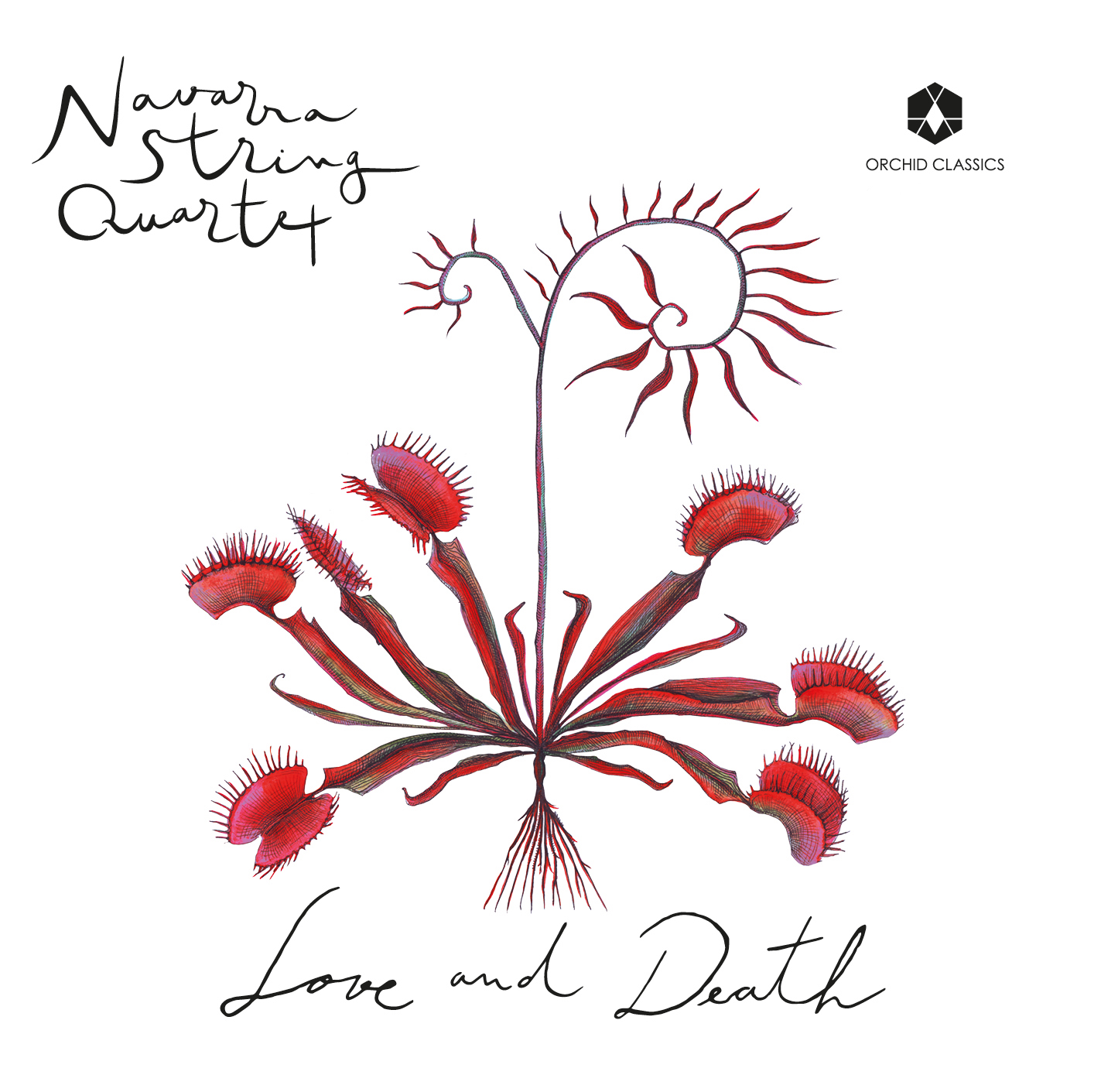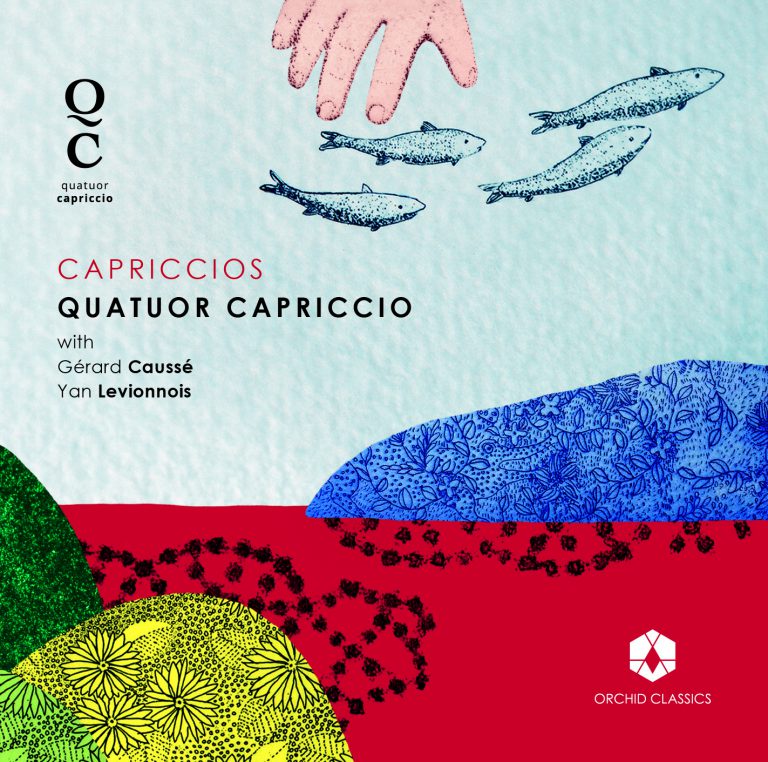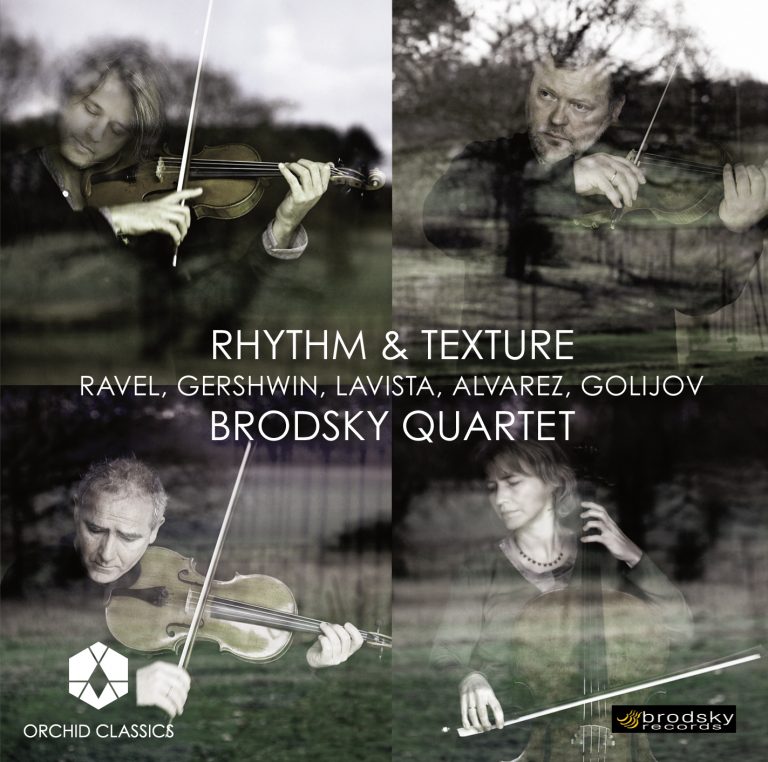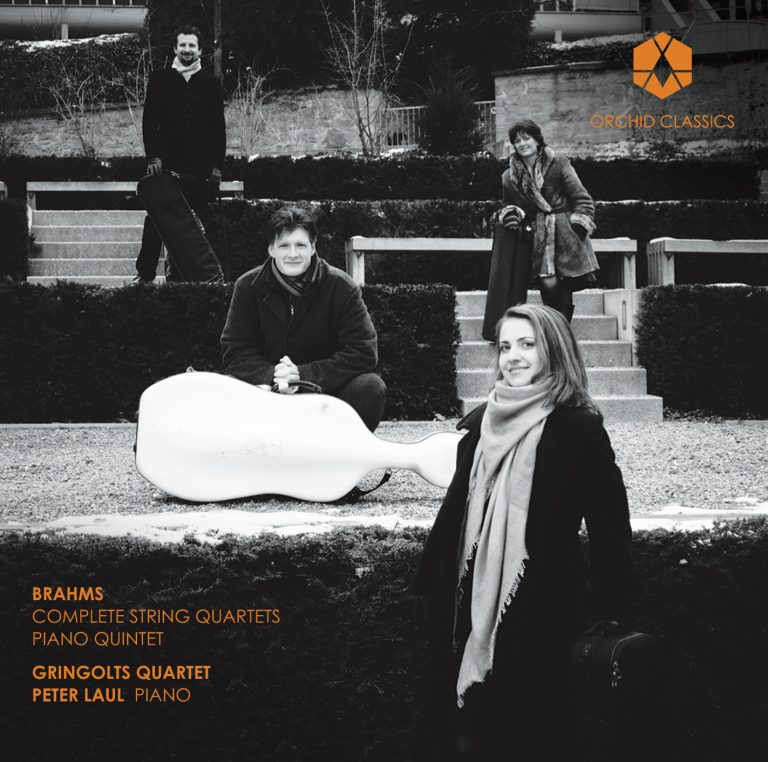Artist Led, Creatively Driven

Love & Death
Navarra String Quartet
Release Date: July 17th
ORC100135
LOVE & DEATH
Joaquín Turina (1882–1949)
1 La oración del torero, Op.34
György Kurtág (b.1926)
2 Ligatura Y
from Jelek, játékok és üzenetek
(Signs, Games and Messages) for string trio
Giacomo Puccini (1858–1924)
3 I crisantemi
Léos Janáček (1854–1928)
String Quartet No.1
4 Adagio
5 Con moto
6 Con moto – Vivo – Andante
7 Con moto (Adagio) – Più mosso
György Kurtág
8 Arioso interrotto (di Endre Szervánszky): Larghetto
from Officium breve in memoriam Andreae Szervánszky
Franz Schubert (1797–1828)
String Quartet in D minor, D810
‘Death and the Maiden’
9 Allegro
10 Andante con moto
11 Scherzo: Allegro molto
12 Presto
Navarra String Quartet
Magnus Johnston, violin
Marije Johnston, violin
Sascha Bota, viola
Brian O’Kane, cello
‘Love and Death’ – an imaginary dialogue
The enigmatic theme ‘Love and Death’ reveals the confrontation of two of human nature‘s unknowns in the works of composers of genius. The seductive courting of the matador before a final paso doble with the bull, a bouquet of mourning flowers written overnight for a deceased friend, intoxicated love leading to an atrocious murder and, finally, Death as lover and saviour from the pain of his suffering bride.
Two little Kurtág bridges both work as mind cleansers before leading the listener to the next tableau, as well as being little jewels in themselves, posing more questions rather than providing answers.
Although all these masterpieces differ greatly, one may question whether it is the very nature of love and death which confers in them a common thread of eternity.
Navarra Quartet, 2020
In 1923 four members of the Aguilar family from Murcia in south-eastern Spain formed a quartet of lutes and, within two years, they had commissioned the Spanish composer Joaquín Turina to write a piece for their ensemble. This turned out to be La oración del torero (The Bullfighter’s Prayer). The published score, not surprisingly, bears a dedication to Elisa, Ezequiel, José and Francisco Aguilar and, as lute quartets are rather a rare breed, permission for string quartets to add this work to their repertoire.
The composer himself has described how he was inspired to write this piece when, one sunny afternoon, he visited the famous bullring in Madrid (the Plaza de toros de las Ventas). While there he discovered the tiny chapel in which bullfighters would pray in silence before venturing out to confront the eager and noisy crowd, the bull and possible death. In this chapel are to be found paintings of both the Virgen de la Paloma (the Virgin of the Dove and unofficial patron saint of Madrid) and the Virgin of Guadalupe, the patron saint of Mexico.
It was in 1973 that György Kurtág began composing the many pieces for piano which he was to call Játékok (Games), the idea having come to him while watching children playing with a piano and treating it as a toy. ‘They experiment with it, caress it, and run their fingers over it’, he noted, ‘and pile up seemingly disconnected sounds.’
At the end of the 1980s, Kurtág arranged some of these pieces for string trio for a collection he was to entitle Jelek, játékok és üzenetek (Signs, Games and Messages). Ligatura Y was originally included in the sixth volume of these piano pieces. (A ligature in musical notation indicates that several notes are to be combined together and it is a term often used by Kurtág; indeed there is also a piece called Ligatura X in this collection.)
As a composer of operas, Giacomo Puccini was very much concerned with the subjects of love and death. Full of impassioned love duets, most of his operas, however, end with the heroine dead, either as a result of suicide, a broken heart or some fatal disease.
On 6 February 1890 Puccini wrote to his brother, Michele, who was at that time living in South America. This letter was written while the composer was in bed suffering from a ‘third attack’ of influenza. It was snowing outside and he told his brother that he needed to stop writing and get under the bedclothes as his arms were very cold. By then his first two operas, Le villi, and Edgar were about to be published and he promised to send Michele the scores of both of them. He also said that he would send him one of I crisantemi (‘chrysanthemums’), a string quartet which had recently been played with great success by Leandro Campanari and his quartet. Puccini went on to mention that he had composed this latter work in one night following the death of Amedeo of Savoy, its title referring to the flowers which are particularly associated with Italian funerals. Amedeo of Savoy, also known as the Duke of Aosta, was the son of King Victor Emmanuel II of Italy, and had himself been King of Spain for a few years in the 1870s. He had died of pneumonia on 18 January 1890 at the age of only forty-four. His cousin – and sister-in-law – was Queen Margherita of Italy who, in 1880, had provided the young Puccini with a grant to enable him leave his native Lucca for further study in Milan.
Like Puccini, Leoš Janáček is perhaps best known for his operas and, as such, he too was no stranger to the subjects of love and death which are also dealt with in some of his orchestral and chamber music, not least in his two string quartets.
It was in 1803, by which time he had started to worry about his encroaching deafness, that Ludwig van Beethoven completed his Violin Sonata in A major, Op.47, a work which, because of its subsequent dedication to the violinist Rudolphe Kreutzer, has become known as the ‘Kreutzer’ Sonata. In 1890 a novella with the same name was published by the Russian writer Leo Tolstoy (1828-1910). In 1908, Janáček decided to compose a piano trio based on Tolstoy’s story and within six months he had completed it. The first performance took place on 2 April 1909 as part of that year’s Tolstoy celebrations but, subsequently it was either lost or, as is quite likely, destroyed by Janáček.
Some fourteen years later, in the autumn of 1923, Janáček returned to Tolstoy’s story, and probably to some of the music that had originally appeared in the piano trio, when he came to compose his First String Quartet. In his novella, Tolstoy had propounded the theory that music is one of the major incitements to adultery. His heroine is unhappily married and tries to regain her happiness by taking a lover who is a violinist. Together they make music, often playing Beethoven’s ‘Kreutzer’ Sonata. This piece greatly disturbs her jealous husband, which he claims to be a ‘fearful thing’, and eventually, in his rage, he stabs her to death.
While the quartet does not attempt to follow Tolstoy’s tale word for word, it is possible to identify in it some of the emotions with which the novella deals.
There is also a brief reference in the third movement to a motif from the Beethoven sonata.
When in the late 1980s Kurtág came to compose what was in fact his third string quartet he wished to pay tribute in it to several recently dead friends and colleagues. Chief among these was the Hungarian composer, Endre Szervánszky (1911-1977), whose name, in a Latin version, forms part of the work’s title and, in the original Hungarian, appears in the description of its final movement. Szervánszky studied the clarinet and composition at the Budapest Academy of Music where, in 1948, he was to be appointed Professor of Composition. It was also at about this time that he composed his Serenade for String Orchestra part of which Kurtág was to incorporate into his Officium breve in memoriam Andreae Szervánszky. The third movement of Szervánszky’s Suite is marked Arioso and Kurtág ended his work with a transcription for string quartet of its first twelve bars before, as the title indicates, it is interrupted.
The Officium breve (Brief tribute) also contains two further references to pieces in which Kurtág had paid homage to Szervánszky (these come from the third volume of his Játékok) and two to Anton Webern’s Cantata, Op.31. The whole work is dedicated to Wilfried Brennecke, at whose Witten Festival in Germany it was given its first performance by the Auryn Quartet on 22 April 1989, and there are also individual dedications to the cellist, Tibor Turcsányi, the mathematician and recorder player, Zsolt Baranyai (who had been killed in a car accident on his way back from a concert), the pianist, György Szoltsányi, and a close friend of Kurtág’s, Gabriella Garzó.
While not known these days for his operas – he began to compose several but, as with his symphonies, he often left them unfinished – Franz Schubert was a prolific writer of songs which deal with all aspects of the human condition, notably love and death.
In 1824 Schubert started composing a string quartet in D minor but it was some two years before he had completed it to his satisfaction. It was first heard on 1 February 1826 at the home of Joseph Barth, a singer at the Viennese Court, but was not published until three years after the composer’s death. Its first public performance was given in Berlin on 12 March 1833.
In his chamber works Schubert often made use of one or other of his many songs. The most famous example of this occurs in his quintet for piano and strings which takes its name from the song, Die Forelle (The Trout), which is quoted within it. Just as Die Forelle is treated to a set of variations in the quintet, so is Der Tod und das Mädchen (Death and the Maiden) in the second movement of the D minor string quartet. Schubert had composed this song in 1817. It is a setting of words by Matthias Claudius (1740-1815) in which the maiden tells the bony figure of death (der Knochenmann) to leave her alone as she is too young to die. However he suggests that she should take his hand as he is her friend and has not come to punish her; be of good cheer he says, assuring her that she will sleep softly in his arms.
© Peter Avis
January 2020
Navarra String Quartet
“The players realize the music’s essential intensity with their vivid sense of dramatic expression in an intensely detailed performance. ”
BBC Music Magazine, September 2009
Commended for poetic lyricism, haunting intensity and stylistic understanding, the British based Navarra String Quartet (NSQ) distinguishes itself as one of the leading ensembles of its generation. Taking its name from a bottle of red from the wine region famously known for its multi-coloured landscapes, the Quartet’s diverse cultural backgrounds are united in serving the music with relentless passion and commitment.
Highlights of the 2019/20 season include debut appearances at the Lincoln Center New York, Heidelberg String Quartet Festival and Stavanger Chamber Music Festival. Following a concert in Latvia for the anniversary concert of Pēteris Vasks, the Quartet is pleased to return to the Wigmore Hall and the Peasmarsh Chamber Music Festival. Previous appearances at major venues throughout the world include the Amsterdam Concertgebouw, Luxembourg Philharmonie, Berlin Konzerthaus, Sydney Opera House and international festivals such as Aix-en-Provence, Grachten, Schwetzinger, Rheingau, Mecklenburg-Vorpommern, and the BBC Proms. The Quartet has also toured extensively to Russia, the USA, China, South Korea and the Middle East.
NSQ enjoys sharing the stage with a variety of partners such as Tom Poster, Mark Simpson, Guy Johnston, Mathias Kjøller, Simone Young and the National Youth Orchestra of Great Britain. Beyond the versatile repertoire from di Lasso to Kurtág, the Quartet finds collaborating with contemporary composers highly nourishing. New commissions by Simon Rowland-Jones, Joseph Phibbs and Manuel Hidalgo are dedicated to the Navarra Quartet and featured in eclectically crafted programmes along with Beethoven and his contemporaries. Highly-acclaimed recordings include Joseph Haydn’s The Seven Last Words for Altara Records and a disc of Pēteris Vasks’ first three String Quartets for Challenge Records, which was recorded whilst working closely with the composer himself. The disc was described by critics as “stunning”, “sensational” and “compelling”, and was nominated for the prestigious German Schallplattenkritik Award.
Driven by the desire to explore new depths, the Quartet plays regularly to revered musicians such as Rainer Schmidt, Eberhard Feltz, Ferenc Rados and Gabor Takács-Nagy. They also enjoy teaching the next generation in masterclass and summer courses. NSQ was the Quartet in Residence at the Royal Northern College of Music and Associated Ensemble at the Birmingham Conservatoire. Selected for representation by the Young Classical Artists Trust (YCAT) in 2006, the Quartet is winner of the MIDEM Classique Young Artist Award, a Borletti-Buitoni Trust Fellowship and top prizes at the Banff, Melbourne and Florence International String Quartet Competitions.
In 2017, the prestigious Kersjes Prize in the Netherlands was awarded to NSQ, enabling the creation of many exciting and unique programmes, such as this very album.
The Quartet plays on a variety of fine instruments which include violins by Hieronymus (II) Amati, and Johannes Franciscus Cuypers, the latter generously on loan from the Nationaal Muziekinstrumenten Fonds in the Netherlands, a modern Marino Capicchioni viola, and a Giovanni Grancino cello made in Milan in 1698, generously on loan from the Cruft-Grancino Trust which is administered by the Royal Society of Musicians.
Since 2014, Navarra Quartet has been in charge of the artistic vision of the Weesp Chamber Music Festival, located in a charming historic city near Amsterdam.
“[The Navarra String Quartet’s] playing has a transparent, febrile energy.”
Fiona Maddocks, The Guardian
“An absorbing collection… the Navarra’s insights have their own rewards, while the recording is a model of ‘quartet sound’.”
Gramophone
“…even the most darkly melancholic works are suffused with the light, expressive touch of the Navarra.”
BBC Music Magazine
“The Navarra Quartet describes this programme as an “imaginary dialogue”, and the unique, conversational rapport of these musicians draws the listener into their intricate musical world.”
Presto Classical
“A hugely enjoyable and rich recording and one which makes me want to see the Navarra Quartet perform live!”
ArtMuseLondon
“…this disc with its generous timing has much to offer the listener in the variety and quality of the works presented…there is no reason to hesitate.”
Music Web International









